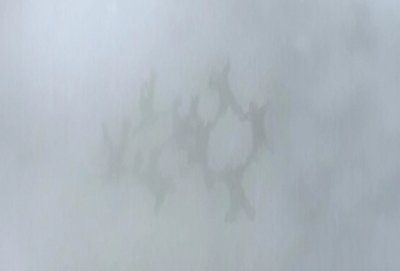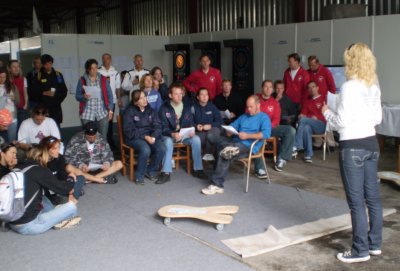
National
Skydiving
League
226 Pecan Street
Deland FL 32724
tel: (386) 801-0804
© 2003 - 2025
All Rights Reserved


226 Pecan Street
Deland FL 32724
tel: (386) 801-0804
© 2003 - 2025
All Rights Reserved


It was surely not the first time that those kind of concerns and complaints reach the NSL News. It is difficult for the active competitors to address their thoughts directly to the judges, even if their team captain or head of delegation speaks up for them. They are afraid of creating tensions and a negative relationship with the same judges who will push the buttons again in the next rounds and/or at the next meets. The NSL News does not have to fear point deductions...
The same articles also caught the attention of the officials, and the NSL News received a few unfriendly responses to the same issues from the other side of the sport. The NSL News asked for permission to publish the comments and will follow up soon. However, the same articles also initiated some productive feedback before the critical responses arrived from judges and officials who attended the event in Germany.
| World Cup 2011 | Round 1 | Round 2 | Round 3 | Round 4 | Round 5 | Round 6 | Round 7 | Round 8 | Round 9 | Round 10 | Total | Avg | |
| Rank | 4way Open | C,22,19 | E,M,1,2 | 12,9,16 | O,8,10 | Q,14,5 | P,17,K,18 | 21,L,J,13 | 3,11,B | 20,G,H,4 | N,F,A,7 | Total | Avg |
| 1 | Aerodyne Aerokart | 22 | 27 | 23 | 22 | 26 | 25 | 25 | 24 | 24 | 37 | 255 | 25.5 |
| 2 | NMP-PCH Hayabusa | 22 | 27 | 23 | 21 | 24 | 25 | 21 | 23 | 24 | 39 | 249 | 24.9 |
| 3 | Paratec-Saar | 16 (-2) | 23 | 19 | 15 | 19 | 18 | 16 | 19 | 20 | 31 | 196 | 19.6 |
| 4 | Sky Panthers Barkli | 18 | 21 | 19 | 16 | 19 | 16 | 15 | 19 | 19 | 33 | 195 | 19.5 |
| 5 | Gradient Alpha | 17 | 21 | 17 | 13 | 20 | 20 | 19 | 18 | 17 | 27 | 189 | 18.9 |
| 6 | EX3MO | 15 (-1) | 19 | 17 | 17 | 17 | 16 | 19 | 18 | 16 | 28 | 182 | 18.2 |
| 7 | Bardagi | 15 | 20 | 17 | 15 | 16 | 14 | 19 | 15 | 17 | 29 | 177 | 17.7 |
| 8 | Dynamite | 14 | 18 | 16 | 16 | 17 | 17 | 17 | 17 | 17 | - | 149 | 16.6 |

He also follows the NSL News coverage of the bigger international events and studies the competition videos carefully. It helps him to be current and keep his eyes well trained. He provides the NSL News with feedback whenever he sees something that could be interesting for teams, competitors and for the audience.
The NSL News has posted Steve Miller's feedback here and there, and he has suggested to create a column similar to the "Coaches Corner" that covers topics of rules and judging. "From the Judges' Room" might soon become the place where teams and competitors can find valuable information. This requires active participation by the judges though, which will hopefully also kick in when there are not such critical and controversial issues as the recent ones. Here is what Steve Miller contributed:
| Interesting article on the judging. FYI - I scored the Knights a 17 on the 8-way notwithstanding that I felt fairly confident that all of the points where there. The rules, however, do not allow me to make that interpretation. Nor do I think they should. To my eyes, recognizing that reasonable eyes may differ, the last two points were not "clearly presented". I also note that I was watching on a small computer screen and using a stopwatch. I was not in the room with the judges on this round and did not see what they saw. It is possible that what was presented to them was different enough to allow them to score the round differently. Here is my take the issues presented in your article.  There is no way to eliminate the human element so long as human beings are doing the judging. Recognizing that the goal is to make judging as objective and as error free as possible, the best that can be hoped for is to reduce inaccuracy, whether actual or perceived, on the part of both competitors (when watching their own skydives) and judges. There will, however, even with super slo-mo, always be situations where judgment calls must be made. Because of this, it is essential that there be objective rules which govern how a point is scored. In this case, the problem does not lie in the rule itself. As a former competitor turned judge, I find no problem with the "clearly presented" language. In a discussion with Dan BC early on in my competitive career, Dan described it like this, "There are only two types of formations in this sport, those that score and those that don't." It really is that simple. The point is either there or it isn't. If it is "clearly presented" it counts, not clearly presented, it doesn't. If, in the course of reviewing one of his/her skydives, a competitor has to ask "was that there" or "was that a bust", they have answered their own question. There is no way to eliminate the human element so long as human beings are doing the judging. Recognizing that the goal is to make judging as objective and as error free as possible, the best that can be hoped for is to reduce inaccuracy, whether actual or perceived, on the part of both competitors (when watching their own skydives) and judges. There will, however, even with super slo-mo, always be situations where judgment calls must be made. Because of this, it is essential that there be objective rules which govern how a point is scored. In this case, the problem does not lie in the rule itself. As a former competitor turned judge, I find no problem with the "clearly presented" language. In a discussion with Dan BC early on in my competitive career, Dan described it like this, "There are only two types of formations in this sport, those that score and those that don't." It really is that simple. The point is either there or it isn't. If it is "clearly presented" it counts, not clearly presented, it doesn't. If, in the course of reviewing one of his/her skydives, a competitor has to ask "was that there" or "was that a bust", they have answered their own question.The human element is most prominent in the determination of what is, in fact, "clearly presented." Normalizing the human element is why we have judging panels rather than just a single judge. Is the "clearly presented" language necessary? In my opinion, probably not. Does removing it or revising it change anything, probably not. Grips are either visible or not. Complete separation is either visible or not. Simple. To answer the inevitable question, yes, I think "clearly presented" and "visible" mean the same thing in this context. I score what I see. Perhaps "visible" is a better word than "clearly presented". Is there a distinction between "visible" and "clearly visible"? I would hope not.  What is the solution? I'm not sure. I like the idea of using slow motion. I have been using it in the SCSL for several years in close situations. Granted, this is not the World Championships or even a USPA Nationals, but it does improve accuracy. I like the new proposal offered by Judy Celaya and adopted by USPA. In my experience we, as judges, will not take any longer to score a jump as a result of using slow motion if it is used correctly. So long as scores can be rendered quickly, preferably prior to the next round, judges should be free to take the steps necessary to score a round as accurately as possible. I also like the idea, on a local/NSL Meet level, of using an open door judging policy. I also use this as part of the SCSL meets to help educate less experienced (and some very experienced) competitors on what judges are looking for, what is or is not a bust, and how rounds are scored. While this is clearly not possible in larger meets, the response has been generally positive and resulted in a greater appreciation of how difficult judging can be, whether with respect to a rookie round or a AAA round. The Brothers Wagner did this for me and the lesson was well received. What is the solution? I'm not sure. I like the idea of using slow motion. I have been using it in the SCSL for several years in close situations. Granted, this is not the World Championships or even a USPA Nationals, but it does improve accuracy. I like the new proposal offered by Judy Celaya and adopted by USPA. In my experience we, as judges, will not take any longer to score a jump as a result of using slow motion if it is used correctly. So long as scores can be rendered quickly, preferably prior to the next round, judges should be free to take the steps necessary to score a round as accurately as possible. I also like the idea, on a local/NSL Meet level, of using an open door judging policy. I also use this as part of the SCSL meets to help educate less experienced (and some very experienced) competitors on what judges are looking for, what is or is not a bust, and how rounds are scored. While this is clearly not possible in larger meets, the response has been generally positive and resulted in a greater appreciation of how difficult judging can be, whether with respect to a rookie round or a AAA round. The Brothers Wagner did this for me and the lesson was well received.Judges will never be perfect (at least I won't) and competitors in any sport should not expect them to be. All we can do as judges is arrive at a meet current and prepared, score a round the best we can in accordance with the rules we are given and strive to be as consistent as possible. Note: This foregoing reflects the writer's opinion only and does not necessarily reflect the opinion of any other judge(s), USPA, FAI or any other person or regulatory body. |

This unusual situation brings back the same issue that was discussed before. The frame images embedded in Steve Miller's contribution for the NSL News show more questionable situations of the "clearly presented" definition. Frame images in the previous articles showed situations where teams had point deductions when formations or maneuvers were not "clearly presented".
This time, the images present the opposite situation, similar to Round 9 of the Golden Knights where the judges were seemingly more generous. Once again, there is no doubt that Gradient Alpha's and Ex3mo's Snowflakes of Block 1 were built correctly and complete. However, are all grips, especially all cat grips, clearly visible and better presented than the Polaris Murphy Flake in Round 1 (see NSL News on 10 August 2011)?
 |  |  |

The pace of the two top teams, Aerodyne Aerokart and NMP-PCH Hayabusa, especially during inters with total separation, doesn't even leave the judges enough time to look for "clearly presented" formations and grips. It is often only one or two frames that show a complete formation or a complete break. That is obviously good enough when the top teams perform - not always when other teams show separation or a formation only for a few frames.
Purpose of this series of video and judging presentation is not finding judging mistakes. They will always happen, as Steve Miller explained. There are judgement calls as in other sports, and there is "the human element". However, goal is to get the results as close as possible to the real truth, get all judges well trained and well prepared and on the same page of interpretation all the time. Provide consistency, continuity and transparency for the athletes, so they can also understand how to get all their points and the rewards for all the time and money they have invested.